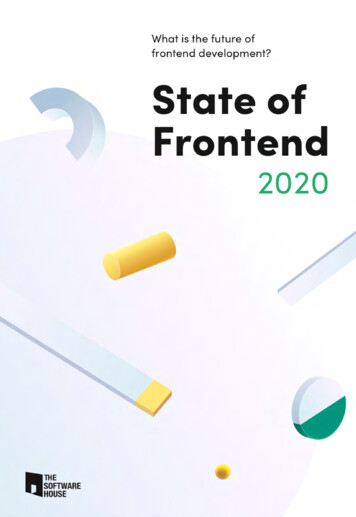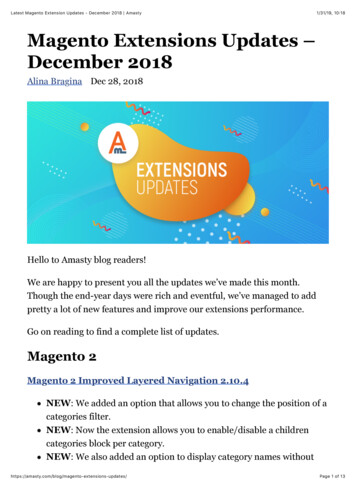
Transcription
1
ExpertsYan CuiAWS Serverless HeroTim NeutkensHead of Next.js at VercelMarek GajdaCTO of The Software HouseGuillermo RauchCEO of VercelJessica JordanDeveloper Advocate at .cultTomek RudzkiHead of R&D at OnelyLuca MezzaliraVP of Architecture at DAZNDylan SchiemannCEO of Living SpecRocky NeurockEngineering Team Leadat Honeypot.ioBartosz SkowrońskiHead of Designat The Software House2
AuthorsPatryk MamczurEditor in ChiefMarcin GajdaTomasz KajtochWiktor ToporekAndrzej WysoczańskiTechnical ConsultingJoanna SwobodaMagdalena HabartaKamil GłowińskiPublication Design3
Table of contents010203040506074DevelopersEveryday frontend development according to 4,500 expertsFrameworksReact is king. But who’s the contender?HostingTraditional DCs, cloud giants and frontend-focused hostingJamstackEcstatic about staticMicro frontendsDo we need microservice revolution in frontend development?Search engine optimizationIt seems that you don’t care about SEO. Here’s why you shouldApplication accessibilityMaking the interface friendly for every user8121824283236
08091011Development teamsFrontend development? It’s a team sportDesignStriving for close collaboration between designers and developersQuality assuranceSoftware testing as the cornerstone of software developmentFuture of frontendState of Frontend 2021?404448525
How many frontend developerstook part in the survey?Total answers: 45001082Western Europe941North America3336Central andSouth America
1071581OtherEastern Europe303Southand East Asia73Middle East7
01.DevelopersEveryday frontend developmentaccording to 4,500 expertsPatryk MamczurReport’s Editor in Chief8
With 4,500 folks fillingin the survey, the Stateof Frontend 2020 isthe biggest report outthere focused solely onfrontend development.When we started thinking about the State of Frontend 2020 report,I had one goal in mind: to find out what the everyday job of a frontenddeveloper looks like. Considering that there are thousands of frontenddevs around the world, that goal seemed pretty unrealistic. But hey man– once again, the frontend community surprised us all!In just a few weeks, exactly 4,500 frontend developers took part in ourState of Frontend survey! I know the number first hand because I wasliterally sitting with my finger on a button, observing the growing numbers and waiting for the perfect moment to close the survey. I don’t knowabout you but for me the number is pretty perfect – as with 4,500 folksfilling in the survey, the State of Frontend 2020 is the biggest report outthere focused solely on frontend development.All in all, we ended up with over four thousand frontend devs telling us abouttheir everyday job, the frameworks that they use, the frameworks that theywould like to use (but, for example, the boss won’t let them) and about their9
thoughts on the recent frontend development trends. The results of thesurvey are awesome – some of them surprising, many of them inspiring,all of them showing how the everyday frontend development looks.To make all this data more accessible, we invited leading software development authorities to comment on the results. With their incredibleknow-how and big-picture perspective, they made the State of Frontend2020 report what it is – the most up-to-date source of knowledge on themodern frontend development.So, I advise you to stop reading my brag-about introduction, take a lookat the table of contents, choose the topics that interest you the most andfind out what both the developers and the authorities have to say about it.You won’t be disappointed.For how long have you been in the frontenddevelopment game?6.2%A few months24.7%More than1 year26%More than3 years1016.9%More than10 years26.1%More than5 years
How would you describe your eloper/ Headof technology30%SeniordeveloperHow big is the company you are working in?7.5%I’m a yees25.5%500 1
02.FrameworksReact is king.But who’s the contender?Dylan SchiemannCEO of Living Spec, Co-creator of Dojo12
One thing is certain:React dominates themind share today.When you look at the results of the State of Frontend survey, one thingis certain: React dominates JavaScript framework mind share today.However, at the same time, it seems that next-generation reactive frameworks may soon rise as lean alternatives to the React ecosystem. And itall has much to do with the rising popularity of TypeScript.For the past several years JavaScript developers have gravitated towardsReact, Vue.js and Angular as the leading frameworks. Relative interestin Angular has decreased due in part to the long delay in shipping Ivyand, similarly, interest in Vue has stalled a bit due to the long-awaitedand somewhat delayed Vue 3.0 release. It all helped React dominate theJavaScript framework market with 74.2% of the survey’s respondents usingit – more than Angular and Vue.js users combined!It doesn’t mean, however, that the React community lives without a carein the world. A major change took place recently when developers started turning away from Redux. We can already see that, when it comesto state management, more people use React Context API and hooks(49.6%) than Redux (48.2%) – of course, some of them still use both butthe trend is visible. Also, as a side note, while discussing big JavaScriptframeworks is important, we must not forget about jQuery which, whilerarely talked about, still remains the most widely deployed JavaScriptlibrary on the web.13
And what about the future of JavaScript? We're already seeing significantinterest in next-generation reactive frameworks such as Svelte whichstrives to provide reactivity on top of normal DOM structures. Yet anothercompetitor is Stencil – a framework focused on web components and,just like Svelte, on efficient compilation. Also, Dojo has re-emerged asa reactive TypeScript-first framework promising intelligent defaults forfaster out-of-the-box experience.Some argue that these next-generation frameworks may be great forsmaller applications but require more work when building large apps.It’s true that all of them provide much smaller default application bundlesizes as they do not carry the same legacy as frameworks which need tosupport features of the past few years. Also, they are very aligned withmodern standards and language features.And this is where we must discuss the growing importance of TypeScript.With 77.2% of respondents already using TypeScript and most of thempreferring it to JavaScript, it’s not surprising that frameworks are improving their support for TypeScript and many start to leverage TypeScriptinternally. It’s true for both the already established frameworks (likeReact and Angular) and the next-generation ones (Stencil and Dojo inparticular).With all these changes going on, I’m really looking forward to seeingwhat happens next in the realm of JavaScript frameworks. Because onething is for sure: React is the king now but there are already a few contenders for the throne waiting.14
Which of these frameworks have you used duringthe last ackbone.js6.2%Otheror noneWhich of these frameworks would you like to keepon using or want to learn in the tVue.jsSvelteAngularPreact6.7%0.9%Ember.js Backbone.js4,6%Otheror none15
Which solutions do you use when it comes to 014.2%8.1%4.2%3%2.1%VueEventBusNGXSEmberData /EmberServices9.5%10.1%OtherNone0React Reduxhooks/ msolutionsHave you used TypeScript during the last year?22.8%No77.2%Yes16
Do you like TypeScript better than JavaScript?6.6%No– JavaScriptfor the win!39.1%I kind of likeboth54.3%Yes, TypeScriptworks betterfor meWhat do you think about the future of TypeScript?1.7%In 2–3 years,everyone willforget aboutTypeScript14.1%JavaScript willremain themore popularchoice29.2%In a few years,JavaScript willturn intosomething likeTypeScript26.6%JavaScript andTypeScriptwill be equallypopular28.4%TypeScript willbecome themore popularlanguage17
03.HostingTraditional DCs, cloud giants andfrontend-focused hostingYan CuiAWS Serverless Heroand Independent Consultant18
The future of frontenddevelopment calls forplatforms such as Netlifyand Vercel which provideeasy-to-use features forfrontend-focused teams.The results of the State of Frontend 2020 survey appear especially interesting when it comes to the subject of hosting. When you look at thenumbers, there’s everything: from traditional DCs through cloud providers to the new kids on the block like Netlify and Vercel.For me, by far the biggest surprise from these results is that 44.3% ofrespondents are still deploying their applications to their own web servers! Once again, it’s a reminder that there is still a massive market fortraditional DCs and that there’s still much growth opportunities for thepublic clouds.It’s not really surprising that Amazon Web Services is the most populardeployment target among the cloud providers (38.7%). However, it mayamaze (pun intended) some of you that the AWS’s share is biggerthan those of Google Cloud Platform (14.2%) and Microsoft Azure (11.5%)combined!19
Also, the fact that Netlify has greater penetration (23.3%) than both GCPand Azure is a testament to how great a job they have done. It strengthens a growing school of thought that the future of frontend developmentcalls for platforms such as Netlify and Vercel, which provide easy-to-useand yet powerful abstractions for backend infrastructures for frontend-focused teams.AWS’s continued push for Amplify would suggest they too see the potential here. And, on the other hand, one can’t help but feel that GCP hada missed opportunity with their acquisition of Firebase all those years agoand their failure to develop it into the market leader it had the potentialto become.20
Where do you usually deployyour applications to?44.3%38.7%23.3%14.2%11.5%8.4%5.6%3.6%21
Do you use Continuous Integration?23.4%No76.6%YesWhich CI solutions have you used duringthe last year?34.9%34.7%33.7%19.4%14.9%14.7%13.3%8.7%22
Do you make use of containerization?38.2%No61.8%YesWhich container management solutions have youused during the last year?89%36.8%17.5%8.2%4.5%4.1%23
04.JamstackEcstatic about staticTim NeutkensHead of Next.js at Vercel24
Let me break the news:we expect an even largershare of developersbuilding Jamstackwebsites in the upcomingmonths.It’s great to see that almost one third of respondents have builta Jamstack ( JavaScript, APIs, Markup) website lately. Also, it makes mepersonally happy that more than half of them have used Next.js – a Reactframework for Jamstack we’ve created at Vercel. And let me break thenews: we expect an even larger share of frontend developers buildingJamstack websites in the upcoming months.To me, the appeal of Jamstack is that it lets us do less and accomplishmore. With Jamstack, instead of rendering a page on every request (Server-Side Rendering), you pre-render a page before request time (StaticGeneration). This can be shared by all edges on a CDN (Content DeliveryNetwork) for optimal performance, higher availability, lower costs andzero maintenance overhead.Furthermore, Jamstack frameworks are evolving beyond staticand adopting the flexibility of dynamic. For example, Next.js allowsyou to statically generate additional pages or regenerate25
existing pages after the production build (Incremental Static Generation).Even if your app has millions of pages, the initial build will completeinstantly as those pages can be generated incrementally.Reusable APIs (the "A" in Jamstack) are on the rise too. The market nowhas many providers of headless CMS, headless e-commerce, headlessidentity, and more. No wonder that frameworks are evolving with thesetrends as well. I’m speaking from experience: Next.js has the previewmode feature which lets you conditionally bypass static generation whenyou’re previewing a page on a headless CMS.I’m very excited about the future of Jamstack. It’s great to see that therespondents are using a wide variety of Jamstack solutions. It shows thatdevelopers are experimenting with different ideas – and that’s pushingthe Jamstack community forward for a more simple and performant web.Have you built JAMstack websites?68.5%No31.5%Yes26
Which static site generators have you usedduring the last year?54.3%51.9%15.5%13%9.4%7.6%5.6%4.9%4.3%3%27
05.MicrofrontendsDo we need microservice revolutionin frontend development?Luca MezzaliraVP of Architecture at DAZN,Author of "Building Micro-Frontends"28
It’s still early days and thereare many lessons to learnbut I believe that microfrontends will evolveand reach maturity – justas microservices did.It's incredibly exciting to see how people are embracing micro-frontendarchitecture nowadays. We already know, that there are many companies around the world using micro frontends – just to mention AmericanExpress, DAZN, IKEA, Spotify and Starbucks. Now, with the results of theState of Frontend survey, we also know that practically ¼ of frontend devshave already developed micro frontends.I think that web components are a great, entry-level solution for developers who are just beginning their adventure with micro frontends –and the results of the survey seem to confirm that. On the other hand,there are quite a few new frameworks available for server-side rendering(e.g., Holocron, Podium and Ara Framework), as well as for client-sidecomposition (e.g., Module Federation or Single SPA). However, you shouldremember that while these frameworks are a great addition to the micro-frontend community, they should be picked carefully – always lookingat the context in which you operate.29
It makes me happy that only 20% of respondents agree with the statement that micro frontends will disappear in 3 years time (see: Chapter11. Future of frontend). I also believe that the future looks promising formicro frontends – they will for sure evolve and possibly reach maturity,just as microservices did in the past few years. In fact, there are alreadyinteresting movements in the TC39 world with the Realms proposal,already in stage 2, that could open up new scenarios for micro frontends.Micro frontends are not a silver bullet but definitely a nice addition toother architectures such as server-side rendering, Jamstack and single-page applications. It's still early days, therefore, there is definitelymore work to do, tons of practices to discover and many lessons to learn.However, I feel very confident that this architecture, when used in theright context, can provide a benefit for scaling projects and teams.Have you used micro frontends?24.4%Yes75.6%No30
How do you compose your micro frontends?6.4%Other5.4%34.8%Web componentsiFrame19.5%Server-siderendering34%Npm packages31
06.Search engineoptimizationIt seems that you don’t care aboutSEO. Here’s why you shouldTomek RudzkiHead of R&D at Onely32
Once you understandGoogle's perspective, itdoesn't take much to buildwebsites that are bothuser-centric and botfriendlyTraffic coming from search engines is crucial for any online business.According to the Wolfgang Digital’s "KPI Report 2020", organic searchis responsible for 43% of traffic. That’s more than direct traffic and paidsearch traffic combined! Still, according to the results of the State ofFrontend 2020 survey, as much as 52% of developers don’t care aboutSEO.I'm not here to cast blame. I guess that some of you develop password-protected, internal applications which don’t have to (or even cannot) be visible in search results. However, in other cases, if you wanta website that’s successful on Google, you must take care of SEO.It’s difficult, as SEO specialists don’t always speak the developers’ language. Allow me to lend a helping hand.Firstly, you should always make sure that Google can properly renderJavaScript on your website. For example, it’s possible that you’re accidentally blocking some scripts in robots.txt or using JavaScript featuresthat are not supported by Googlebot. I recommend that you use the33
Mobile-Friendly Test or the URL Inspection Tool – they are free, easy-touse tools provided by Google. Using them, inspect the DOM to ensure allimportant sections of your page can be properly rendered by Google.Also, according to the survey, over 11% of developers use dynamic rendering (which is essentially detecting search engine bots and serving thema static version of your page). Google calls it "a workaround for crawlers".It’s risky, as dynamic rendering sometimes fails – I’ve seen websites presenting Googlebot with blank pages, causing their organic traffic to dropto zero. Thus, always make sure you thoroughly test if dynamic renderingworks as expected.SEO is crucial for many businesses, and rendering is just one of many aspects of SEO. You have to put as much focus on using proper HTML tagsand designing a logical website structure as you do on choosing betweenserver-side rendering, client-side rendering and dynamic rendering.Once you understand Google's perspective, it doesn't take much to buildwebsites that are both user-centric and bot-friendly.Do you take care of Search Engine Optimization?48.4%Yes51.6%No34
How do you approach the subject of SEO?4%Other11.3%Detecting webcrawlers at theHTTP serverlevel60%Using SSR to renderthe whole page24.6%Using SSR torender the metatags in the headsection35
07.ApplicationaccessibilityMaking the interface friendlyfor every userRocky NeurockEngineering Team Lead at Honeypot.io36
I do think the key toincreased accessibility,and better experiencesoverall, is for those of us“in the know” to reallyteach our counterpartsabout the benefitsof accessibility."Don't break the web", my friend Melanie Sumner often admonishes.As developers, we're often last in line to promote accessibility in our work.To escape this pattern, we need a shift in thinking. Accessibility won'tcome to us – we must become great teachers to our peers so the webcan work for everyone.This topic is near and dear to my heart. Not only because I really careabout user experience but also because I suffer from impaired vision.I can say with surety that the web doesn't work for me. Small text and lowcontrast ratios affect me the most but I routinely encounter other frustrations.For example, non-native components that reimagine select elementsor checkboxes – they can frustrate any user if not done extremely well.37
Firstly, consider how nerve-racking these experiences can be for usersthat prefer getting around the web with their keyboards or for users onmobile devices. Then, think about users with assistive devices. Yes, theirexperience is even worse.It’s good to see that developers who take care of accessibility seem familiar with most of the basic Web Content Accessibility Guidelines (WCAG).In the future, we should also try to find out how many people test foraccessibility. There is an ever-increasing number of tools to automaticallytest accessibility and I wonder if an increase in adoption would correlateto an increase in the percentage of developers who feel responsible foraccessibility.I do think the key to increased accessibility, and better experiences overall, is for those of us "in the know" to really teach our counterparts aboutthe benefits of accessibility. If we can free up some of our own time withautomated tests, even better.Do you take care of application accessibility?55%Yes45%No38
How do you take care of application accessibility?88.9%76.6%73.3%70%2.6%39
08.DevelopmentteamsFrontend development?It’s a team sportGuillermo RauchCEO of Vercel40
Recent trendsin frontend architectureand deploymentinfrastructure haveinfluenced how frontenddevelopers collaboratewith their team members.Frontend development is a team sport – shown clearly with 92% ofthe respondents stating they’ve worked as part of a development teamduring the last year. However, recent trends in frontend architectureand deployment infrastructure have influenced how frontend developerscollaborate with their team members. At Vercel, we’ve seen that firsthand.With the rise of new frontend architectures like Jamstack, frontend developers can deploy the frontend independent of the backend. They nolonger have to wait for the full backend test suite to run, resultingin faster iterations. Furthermore, there’s a rise in off-the-shelf backendAPIs (e.g., headless CMS, identity providers, etc.) that can easily beplugged into your frontend. This enables backend developers to focusmore on developing APIs that are unique to the business.The next change is connected to working with designers and productowners. Because Jamstack apps can be deployed quickly and cheaply41
to the CDN edge, it’s possible to assign a unique "preview" URL to everybranch and every commit. We’ve done that at Vercel – now, designersand product owners can simply click on the preview URL and instantlysee if the changes made by the frontend developer look and work asintended. Much more effective than sharing screenshots and GIFs.And, finally, software testing. With the introduction of puppeteer,Chrome’s headless web browser, combined with serverless compute,end-to-end testing is now fast and cheap. For example, you can haveservices like Checkly run puppeteer tests — written by QA specialists— against the preview URL. Also, with the rise of Vercel and other frontenddeployment platforms which do all the heavy lifting, DevOps engineerscan spend less time supporting frontend developers.Overall, we’re very excited about how improvements in frontend architecture and deployment infrastructure are driving changes in developercollaboration. We’re looking forward to see more innovations in thisspace.Have you worked as part of a development teamduring the last year?7.7%No92.3%Yes42
Which of these people were part of yourproject development team(s)?90.8%71.3%64.5%61%50.8%46.4%11.8%2.9%43
09.DesignStriving for close collaborationbetween designers and developersBartosz SkowrońskiHead of Design at The Software House44
With product designerson board, softwarecompanies focus moreand more on creatingstrategies and productsthat go togetherwith the business goalsof their clients.The debate over the role of graphic designers in software developmentteams is nothing new – I remember discussing this topic 10 years ago(maybe even before that). However, it seems that we’re finally in theplace where having a designer working closely with your developers isnot a fad anymore but rather a standard. And we’ve got pretty greattools to make this collaboration even better.Probably the most basic categorization of design types in software development is: UX design (taking care of the best user experience possible), UIdesign (making sure that the interfaces have proper look and feel)and product design (thinking about the business of the client and ofachieving their business goals). Nowadays, it’s becoming a standard forsoftware development companies to have two kinds of designers on board– user-focused UX/UI designers and business-focused product designers.45
The emergence of product designers makes me especially happy.It means that we, as software companies, focus more and more on thereal needs of our clients, on creating strategies and products that gotogether with their business goals. And it seems that clients start to appreciate this change – over 70% of development teams around the worldalready have at least one designer on board (see: Chapter 8. Development teams). Instead of hiring external, freelance designers, clients gofor inclusive teams where developers and designers (as well as projectmanagers, software testers and others) can collaborate closely.In order to make this collaboration fruitful, we need good tools. For years,designers were using software like Adobe Photoshop as it was hard tofind tools tailored to the needs of designers working in the software development business. Fortunately, now we’ve got plenty of those – Figma,InVision, Sketch and Zeplin just to name a few. They make everything easier: creating vector graphics, collaborating with other designers, handingoff designs to frontend developers. It’s great that 71.7% of developmentteams already use such tools.Although the love between designers and frontend developers can betough, I think that with the popularisation of inclusive development teamsand the emergence of even better design and handoff tools, we can alllook into the future with confidence.46
Have you used any handoff tools when workingwith designers during the last year?28.3%No71.7%YesWhich handoff tools have you used?52.5%42.2%23.2%6.7%5.4%8.3%47
10.QualityassuranceSoftware testing as the cornerstoneof software developmentJessica JordanDeveloper Advocate at .cult48
Software testing andmodern frontenddevelopment areinseparable subjects.Nowadays, an increasing amount of the functionality of digital productsis implemented on the client-side. This makes it obligatory for us – bothsoftware engineers and QA specialists – to make testing part of ourworkflow for developing, maintaining and scaling JavaScript applications.It's good to see that as much as 80% of frontend devs already performsoftware tests and numbers seem to be increasing over the years.Luckily, the JavaScript ecosystem offers us a wide set of tools to buildrobust test suites with sufficient code coverage for the apps we build.In recent years, we see a trend in the JS testing ecosystem to make testingcontinuously easier to use – with a focus on improving developer ergonomics, integration with other testing solutions and many other aspects.At .cult, many of our software projects – including the application powering our popular job platform Honeypot.io – are automatically testedand gain more testing coverage as code bases grow. Additionally, our QAteam manually tests and verifies that the feature requirements are fullymet both in functionality and in design – an essential part of our releaseworkflow to guarantee excellent user experience.Even though our teams allocate additional time for manual and automated testing when developing our platform, we have seen – time and time49
again – that software testing is a necessary investment in the stabilityof our digital products, ultimately leading to increased productivity in ourworkflow overall. We trust in tools such as Capybara, RSpec, Ember CLIand QUnit for unit, integration and end-to-end testing. And, of course,there are even more solutions out there for you to choose from.At .cult, we believe that the continued growth of the tooling ecosystemfor testing will soon allow us to cover an even larger part of the productdevelopment workflow through automation. And why do we do that?Because we know that software testing and modern frontend development are inseparable subjects.Who was responsible for testing in your softwaredevelopment teams?4.1%QA specialists only15.7%Mostly QAspecialists20%Mostly softwaredevelopers5037.6%Softwaredevelopers and QAspecialists together22.5%Softwaredevelopers only
Have you performed software tests yourselfduring the last year?19,9%No80.1%YesWhat kinds of tests have you performed yourself?88%56.2%55.9%51
11.Future offrontendState of Frontend 2021?Marek GajdaCTO of The Software House52
In the frontenddevelopment community,the line between loveand hate is very thin.Am I surprised by the results of the survey and the recent changesin frontend development? Not really. Am I surprised by how quick thesechanges occur? Definitely yes. And that’s why predicting the futureof frontend is not an easy task.When you look at the state of frontend development, there are somewell-established technologies, tools, good practices – choices that seemobvious. Let’s take JavaScript frameworks. When you see that there aremore people using React than those using Angular and Vue.js combined(see: Chapter 2. Frameworks), you realise that React has gained such asolid reputation that it probably isn’t going anywhere in the near future.However, in the frontend development community, the line between loveand hate is very thin. And probably the best proof of that is what happened to Redux. A year or two ago, when you were working with React,Redux was also “the obvious choice”. But frontend developers got tiredof the problems caused by using Redux and quickly jumped on the Reacthooks bandwagon. It’s summer 2020, already more people use hooksthan Redux (see: Chapter 2) and as much as 34% of frontend devs believethat Redux will be gone in 3 years from now.53
Also, the world of frontend development is getting more and more complex. Again, a year or two ago, solutions like Continuous Integration andcontainerization were considered more of a backend thing. But, in themeantime, frontend developers realised that they too can benefit fromusing those solutions. Now, 77% of frontend devs use CI and 62% usecontainers (see: Chapter 3. Hosting) making them a new standardin frontend development.So, how will the state of frontend development change in the next 12months? Will Svelte become one of the 3 most popular frameworks?Will micro frontends reach maturity? Nobody can tell for sure but, in myopinion, one thing is certain: we’ll be surprised by how quick some of thechanges will occur.That said, see you soon in the State of Frontend 2021 report!54
Which of these trends/solutions will be prettymuch dead in 3 years from .9%7.5%55
56www.tsh.io
all has much to do with the rising popularity of TypeScript. For the past several years JavaScript developers have gravitated towards React, Vue.js and Angular as the leading frameworks. Relative interest in Angular has decreased due in part to the long delay in shipping Ivy and, similarly, interest in Vue has stalled a bit due to the long-awaited










